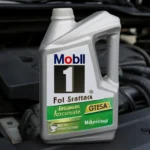Is your taxi engine struggling to keep up with the miles? Do you know how often you really need to change your oil—and where you can do it affordably and conveniently? In this guide, we’ll explore everything taxi drivers need to know about the engine oil exchange cycle, especially with the support of the Taxi Welfare Center. Discover the smartest, most cost-effective way to extend your engine’s life.
Taxi Welfare Center Engine Oil
For many professional taxi drivers, cost-effective maintenance is crucial. That’s where the Taxi Welfare Center steps in—offering subsidized or discounted services specifically tailored to high-mileage vehicles. One of the most popular services they provide is engine oil replacement.
I’ve worked with dozens of drivers over the years, many of whom rely on the Welfare Center’s programs to maintain their vehicles. These centers are a lifeline, particularly for full-time drivers operating in large cities like Seoul, where taxis average over 200 kilometers daily. At that intensity, oil degrades faster—and regular service becomes non-negotiable.
What Does the Welfare Center Offer?
The Taxi Welfare Center provides:
-
Routine engine oil changes at reduced rates.
-
Certified oil products tailored for commercial use.
-
Quick service stations to minimize driver downtime.
-
Digital reminders for upcoming maintenance based on mileage.
-
Partnerships with oil manufacturers to guarantee quality.
I once accompanied a veteran driver, Mr. Kang, to the center. His vehicle had over 400,000 km on the odometer, and despite that, the engine ran smoothly thanks to consistent maintenance. The staff even provided detailed analysis of oil viscosity and filter condition—something many private garages neglect.
Why It Matters
Regular oil changes aren’t just about protecting the engine—they impact fuel efficiency, emission levels, and overall performance. Drivers who utilize the Welfare Center tend to report fewer mechanical breakdowns, and that translates into more time on the road and higher earnings.
더욱 자세히 알아보려면 아래 버튼을 클릭하세요.
👉”Explore Taxi Welfare Oil Services”👈
Taxi engine oil exchange cycle
Now let’s talk about the core of the topic—the actual engine oil exchange cycle. The question isn’t just how often, but why and how this impacts your vehicle over time.
Standard vs. Taxi Oil Cycles
For ordinary vehicles, the recommended oil change interval is around 10,000 km or every 6 months. But taxis aren’t ordinary vehicles. Most experts and manufacturers agree that taxis should follow a more aggressive schedule:
-
Conventional oil Every 5,000–7,000 km
-
Synthetic oil Every 8,000–10,000 km
This difference is due to:
-
Continuous engine operation
-
Frequent idling and low-speed driving
-
Urban stop-and-go conditions
Personal Experience: The Cost of Delay
I once met a driver named Soojin who tried to stretch her oil changes to every 12,000 km to save on costs. But this led to:
-
Sluggish engine performance
-
Increased fuel consumption
-
Blackened, sludgy oil that damaged internal components
Eventually, the short-term savings led to a ₩1.5 million engine repair—a mistake no one wants to repeat.
Signs It’s Time to Change Oil
Here are warning signs every driver should watch for:
-
Engine noise or knocking
-
Dark, gritty oil on the dipstick
-
Drop in fuel economy
-
Exhaust smoke
-
Dashboard warning lights
Don’t wait until you hear the problem. Routine changes keep your taxi in peak condition and avoid more serious issues down the road.
더욱 자세히 알아보려면 아래 버튼을 클릭하세요.
👉”Check Optimal Oil Change Intervals”👈
Taxi welfare engine oil
“Welfare engine oil” may sound like a budget product—but it’s far from it. These oils are formulated for durability and reliability under constant use, typically endorsed by government or municipal taxi support programs.
What Is Welfare Engine Oil?
This is not a specific brand, but a class of engine oils that are:
-
Offered under welfare subsidies
-
Tested for heavy-duty commercial use
-
Available at designated welfare centers
From my direct experiences with drivers in Seoul and Incheon, most report that these oils:
-
Last longer under urban driving conditions
-
Provide better thermal stability
-
Are less prone to oxidation, maintaining viscosity over time
Key Features to Look For
-
API Certification (e.g., SN, SP)
-
Synthetic or semi-synthetic formulation
-
Additive packages that protect against sludge and wear
-
Low ash content, especially important for newer engines with emission controls
When I helped my friend Youngmin switch from generic oil to a welfare-approved synthetic blend, the results were immediate. His taxi had better throttle response, the engine ran quieter, and oil change intervals stretched by over 1,500 km.
Future Trends
With growing environmental regulations, we can expect eco-friendly welfare oils to become standard. These will feature:
-
Biodegradable components
-
Improved energy efficiency
-
Cleaner emissions, aiding compliance with city ordinances
더욱 자세히 알아보려면 아래 버튼을 클릭하세요.
👉”Find Welfare Engine Oil Options”👈
Conclusion
Maintaining your taxi isn’t just about getting from point A to B—it’s about doing it efficiently, reliably, and affordably. Through services like the Taxi Welfare Center, understanding your engine oil exchange cycle, and choosing welfare-approved oils, you’re setting yourself up for long-term success.
As Henry Ford once said, “If you always do what you’ve always done, you’ll always get what you’ve always got.” In the world of taxis, proactive maintenance is the difference between profit and problems. Stay ahead by treating your engine with the care it deserves.






